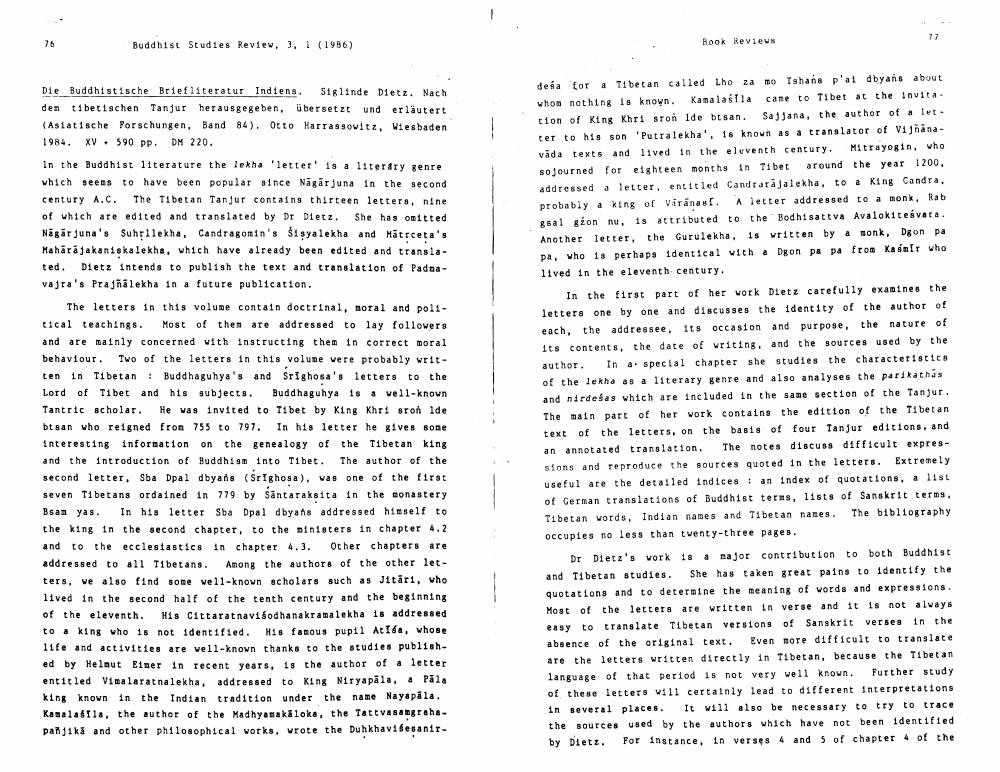________________ Buddhist Studies Review, 3, 1 (1986) Book Reviews 77 Die Buddhistische Briefliteratur Indiens. Siglinde Dietz. Nach dem tibetischen Tanjur herausgegeben, ubersetzt und erlautert (Asiatische Forschungen, Band 84). Otto Harrassowitz, Wiesbaden 1984. XV + 590 pp. DM 220. In the Buddhist literature the lekha 'letter' is a literary genre which seems to have been popular since Nagarjuna in the second century A.C. The Tibetan Tanjur contains thirteen letters, nine of which are edited and translated by Dr Dietz. She has omitted Nagar juna's Suhrllekha, Candragomin's Sisyalekha and Matrceta's Maharajakaniskalekha, which have already been edited and translated. Dietz intends to publish the text and translation of Padma - vajra's Prajnalekha in a future publication. desa for a Tibetan called Lho za mo 'Tshans p'ai dbyans about whom nothing is known. Kamalasila came to Tibet at the invitation of King Khri sron Ide btsan. Sajjana, the author of a leta ter to his son 'Putralekha', 16 known as a translator of Vijnanavada texts and lived in the eleventh century. Mitrayogin, who sojourned for eighteen months in Tibet around the year 1200, addressed a letter, entitled Candrarajalekha, to a King Candra, probably a king of Varanass. A letter addressed to a monk, Rab 88al gzon nu, is attributed to the 'Bodhisattva Avalokitesvara. Another letter, the Gurulekha, is written by a monk, Dgon pa pa, who is perhaps identical with a Dgon pa pa from Kasmir who lived in the eleventh century. The letters in this volume contain doctrinal, moral and political teachings. Most of them are addressed to lay followers and are mainly concerned with instructing them in correct moral behaviour. Two of the letters in this volume were probably written in Tibetan : Buddhaguhya's and Srighosa's letters to the Lord of Tibet and his subjects. Buddha guhya is a well-known Tantric scholar. He was invited to Tibet by King Khri sron ide btsan who reigned from 755 to 797. In his letter he gives some interesting information on the genealogy of the Tibetan king and the introduction of Buddhism into Tibet. The author of the second letter, Sba Dpal dbyans (SrIghosa), was one of the first seven Tibetans ordained in 779 by santaraksita in the monastery Bsam yas. In his letter Sba Dpal dbyang addressed himself to the king in the second chapter, to the ministers in chapter 4.2 and to the ecclesiastics in Chapter 4.3. Other chapters are addressed to all Tibetans. Among the authors of the other letters, we also find some well-known scholars such as Jitari, who lived in the second half of the tenth century and the beginning of the eleventh. His Cittaratnavisodhanakramalekha 18 addressed to a king who is not identified. His famous pupil At Iba, whose 11fe and activities are well-known thanks to the studies published by Helmut Eimer in recent years, is the author of a letter entitled Vimalaratnalekha, addressed to King Niryapala, a Pala king known in the Indian tradition under the name Naya pala. Kamalasila, the author of the Madhyamakaloka, the Tattvasangrahapanjika and other philosophical works, wrote the Duhkhavisesanir In the first part of her work Dietz carefully examines the letters one by one and discusses the identity of the author of each, the addressee, its occasion and purpose, the nature of its contents, the date of writing, and the sources used by the author. In a. special chapter she studies the characteristics of the lekha as a literary genre and also analyses the parikathas and nirdesas which are included in the same section of the Tanjur. The main part of her work contains the edition of the Tibetan text of the letters, on the basis of four Tanjur editions, and an annotated translation. The notes discuss difficult expressions and reproduce the sources quoted in the letters, Extremely useful are the detailed indices : an index of quotations, a list of German translations of Buddhist terms, lists of Sanskrit terms, Tibetan words, Indian names and Tibetan names. The bibliography occupies no less than twenty-three pages. Dr Dietz's work is a major contribution to both Buddhist and Tibetan studies. She has taken great pains to identify the quotations and to determine the meaning of words and expressions. Most of the letters are written in verse and it is not always easy to translate Tibetan versions of Sanskrit verses in the absence of the original text. Even more difficult to translate are the letters written directly in Tibetan, because the Tibetan language of that period is not very well known. Further study of these letters will certainly lead to different interpretations in several places. It will also be necessary to try to trace the sources used by the authors which have not been identified by Dietz. For instance, in verses 4 and 5 of chapter 4 of the




